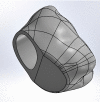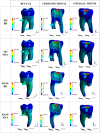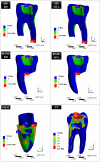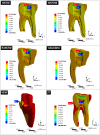Finite element evaluation of dentin stress changes following different endodontic surgical approaches
- PMID: 38184512
- PMCID: PMC11269338
- DOI: 10.1007/s10266-023-00882-1
Finite element evaluation of dentin stress changes following different endodontic surgical approaches
Abstract
The aim was to compare the effect of different endodontic surgical treatments on the stress distributions in dentin of a simulated first mandibular molar tooth using the finite element analysis method. Three surgical endodontic procedures (apical resection, root amputation, and hemisection) were simulated in a first mandibular molar. Biodentine or mineral-trioxide-aggregate was used to repair the surgery site in apical resection and root amputation models; the remaining root canal spaces were filled with gutta-percha. Access cavities were restored using resin composite. In hemisection model, root canal was filled with gutta-percha, and coronal restoration was finished with a monolithic zirconia crown. A sound tooth model was created as a control model. An oblique force of 300 N angled at 45° to the occlusal plane was simulated. Maximum von Mises stresses were evaluated in dentin near the surgery regions and the entire tooth. Apical resection/Biodentine and apical resection/mineral-trioxide-aggregate models generated maximum von Mises stresses of 39.001 MPa and 39.106 MPa, respectively. The recorded maximum von Mises stresses in root amputation models were 66.491 MPa for root amputation/Biodentine and 73.063 MPa for root amputation/mineral-trioxide-aggregate models. The highest maximum von Mises stress value among all models was observed in the hemisection model, measuring 138.87 MPa. Hemisection induced the highest von Mises stresses in dentin, followed by root amputation and apical resection. In apical resection, Biodentine and mineral-trioxide-aggregate did not show a significant difference in stress distribution. Biodentine in root amputation may lead to lower stresses compared to mineral-trioxide-aggregate.
Keywords: Apical resection; Biodentine; Hemisection; Mineral trioxide aggregate; Monolithic zirconia; Root amputation.
© 2024. The Author(s).
Conflict of interest statement
The authors declare that they have no conflict of interest.
Figures







References
MeSH terms
Substances
LinkOut - more resources
Full Text Sources

